Financial Accounting Assignment Solution: Comprehensive Analysis
VerifiedAdded on 2022/11/24
|27
|4911
|421
Homework Assignment
AI Summary
This financial accounting assignment solution provides a detailed analysis of various concepts. The introduction covers financial accounting's role in generating financial information. Question 1 defines different types of business transactions, including cash, credit, internal, and external transactions, along with explanations of single and double-entry bookkeeping, and the importance of a trial balance. Question 2 provides journal entries for various transactions and ledger accounts, while Question 3 differentiates between financial statements and financial reports. Question 4 discusses key accounting principles such as economic entity, going concern, cost, full disclosure, revenue recognition, and matching principles. Question 5 presents profit and loss calculations and balance sheet preparation. The second part of the solution includes scenario-based questions, with Question 1 focusing on bank reconciliation, Question 2 on control accounts, Question 3 on the suspense account, Question 4 on preparing an updated cash book and bank reconciliation statement, and Question 5 on journal entries. The assignment covers a wide range of financial accounting topics, providing a comprehensive understanding of the subject.

Financial Accounting
Paraphrase This Document
Need a fresh take? Get an instant paraphrase of this document with our AI Paraphraser

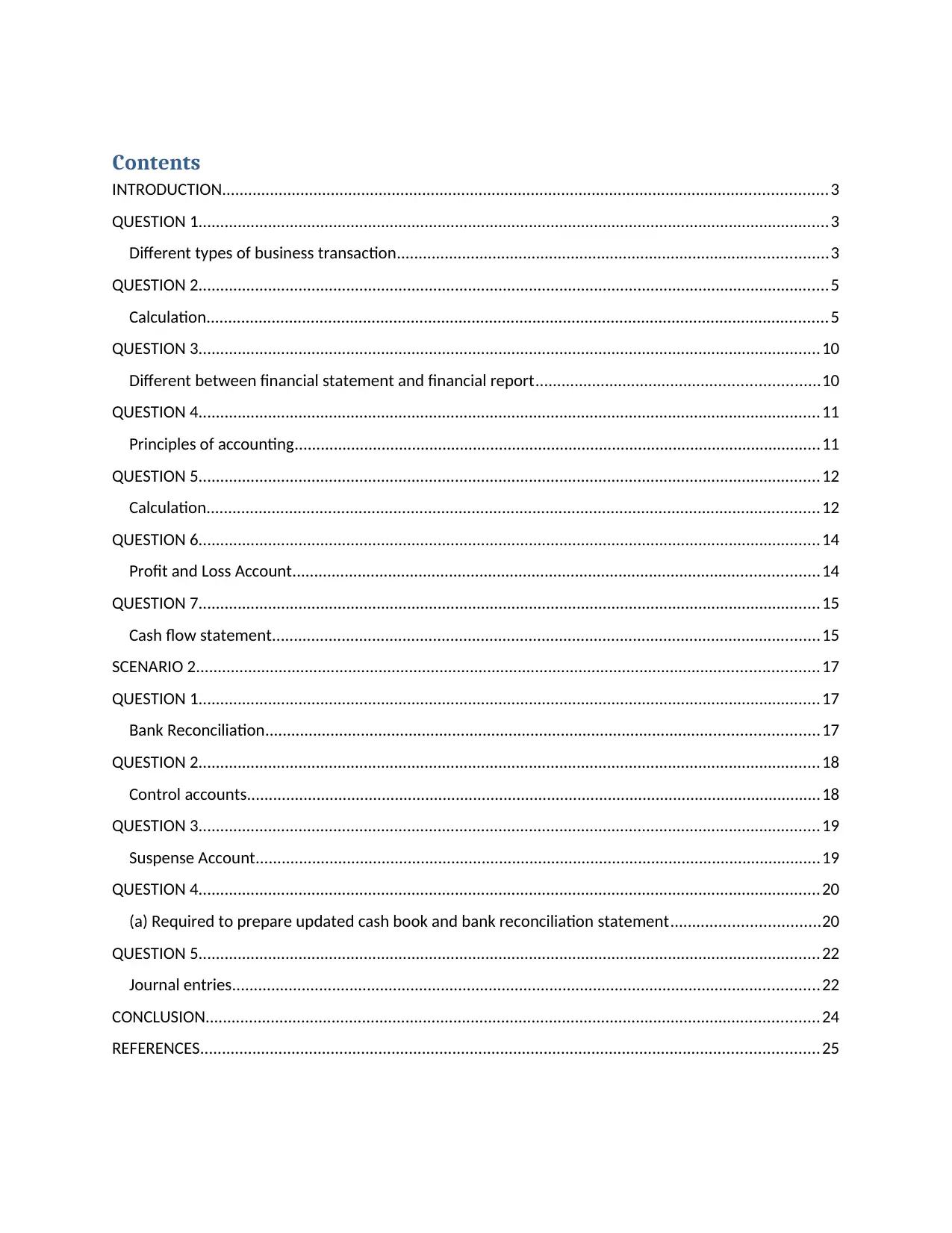
Contents
INTRODUCTION...........................................................................................................................................3
QUESTION 1.................................................................................................................................................3
Different types of business transaction...................................................................................................3
QUESTION 2.................................................................................................................................................5
Calculation...............................................................................................................................................5
QUESTION 3...............................................................................................................................................10
Different between financial statement and financial report.................................................................10
QUESTION 4...............................................................................................................................................11
Principles of accounting.........................................................................................................................11
QUESTION 5...............................................................................................................................................12
Calculation.............................................................................................................................................12
QUESTION 6...............................................................................................................................................14
Profit and Loss Account.........................................................................................................................14
QUESTION 7...............................................................................................................................................15
Cash flow statement..............................................................................................................................15
SCENARIO 2...............................................................................................................................................17
QUESTION 1...............................................................................................................................................17
Bank Reconciliation...............................................................................................................................17
QUESTION 2...............................................................................................................................................18
Control accounts....................................................................................................................................18
QUESTION 3...............................................................................................................................................19
Suspense Account..................................................................................................................................19
QUESTION 4...............................................................................................................................................20
(a) Required to prepare updated cash book and bank reconciliation statement..................................20
QUESTION 5...............................................................................................................................................22
Journal entries.......................................................................................................................................22
CONCLUSION.............................................................................................................................................24
REFERENCES..............................................................................................................................................25
INTRODUCTION...........................................................................................................................................3
QUESTION 1.................................................................................................................................................3
Different types of business transaction...................................................................................................3
QUESTION 2.................................................................................................................................................5
Calculation...............................................................................................................................................5
QUESTION 3...............................................................................................................................................10
Different between financial statement and financial report.................................................................10
QUESTION 4...............................................................................................................................................11
Principles of accounting.........................................................................................................................11
QUESTION 5...............................................................................................................................................12
Calculation.............................................................................................................................................12
QUESTION 6...............................................................................................................................................14
Profit and Loss Account.........................................................................................................................14
QUESTION 7...............................................................................................................................................15
Cash flow statement..............................................................................................................................15
SCENARIO 2...............................................................................................................................................17
QUESTION 1...............................................................................................................................................17
Bank Reconciliation...............................................................................................................................17
QUESTION 2...............................................................................................................................................18
Control accounts....................................................................................................................................18
QUESTION 3...............................................................................................................................................19
Suspense Account..................................................................................................................................19
QUESTION 4...............................................................................................................................................20
(a) Required to prepare updated cash book and bank reconciliation statement..................................20
QUESTION 5...............................................................................................................................................22
Journal entries.......................................................................................................................................22
CONCLUSION.............................................................................................................................................24
REFERENCES..............................................................................................................................................25
⊘ This is a preview!⊘
Do you want full access?
Subscribe today to unlock all pages.

Trusted by 1+ million students worldwide
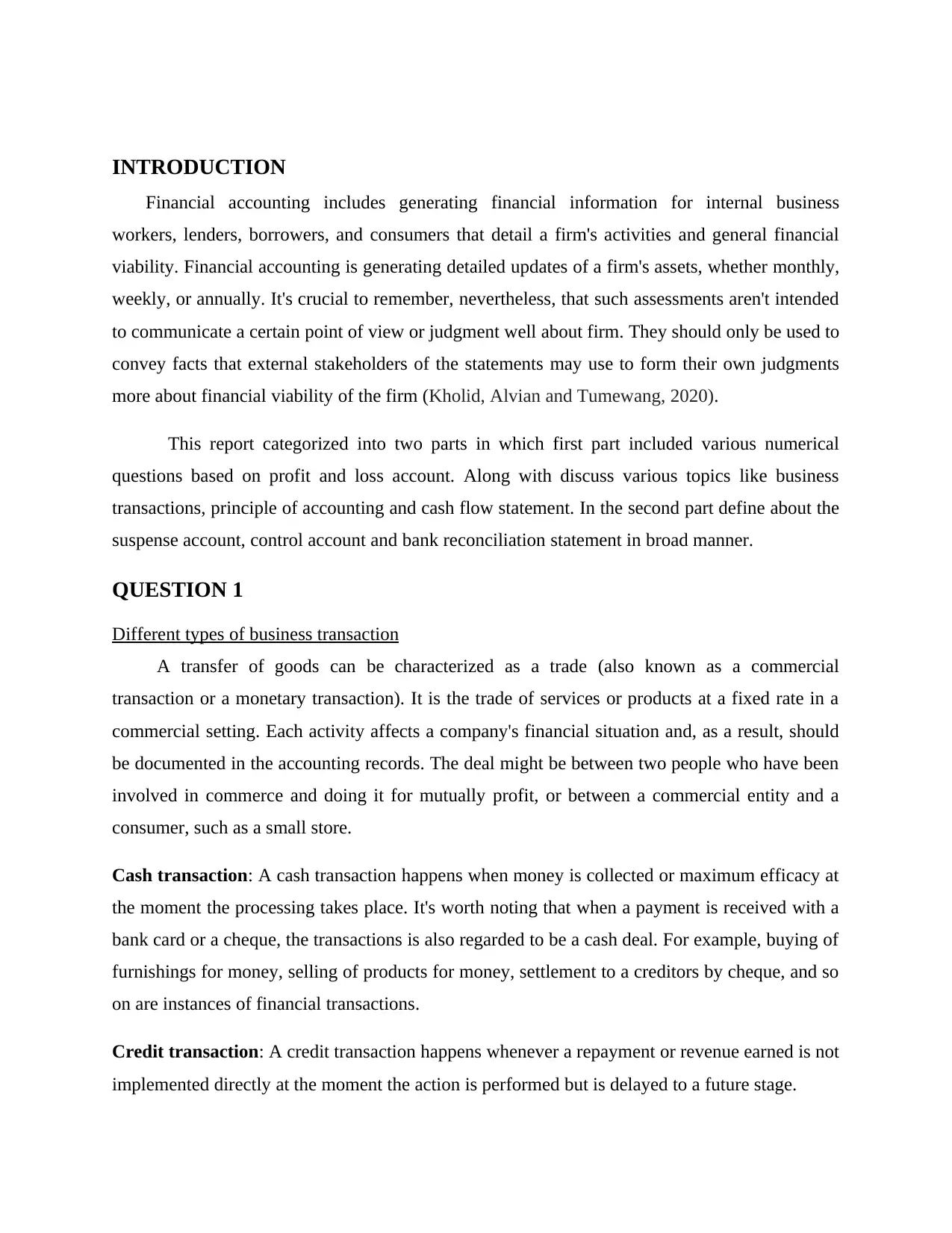
INTRODUCTION
Financial accounting includes generating financial information for internal business
workers, lenders, borrowers, and consumers that detail a firm's activities and general financial
viability. Financial accounting is generating detailed updates of a firm's assets, whether monthly,
weekly, or annually. It's crucial to remember, nevertheless, that such assessments aren't intended
to communicate a certain point of view or judgment well about firm. They should only be used to
convey facts that external stakeholders of the statements may use to form their own judgments
more about financial viability of the firm (Kholid, Alvian and Tumewang, 2020).
This report categorized into two parts in which first part included various numerical
questions based on profit and loss account. Along with discuss various topics like business
transactions, principle of accounting and cash flow statement. In the second part define about the
suspense account, control account and bank reconciliation statement in broad manner.
QUESTION 1
Different types of business transaction
A transfer of goods can be characterized as a trade (also known as a commercial
transaction or a monetary transaction). It is the trade of services or products at a fixed rate in a
commercial setting. Each activity affects a company's financial situation and, as a result, should
be documented in the accounting records. The deal might be between two people who have been
involved in commerce and doing it for mutually profit, or between a commercial entity and a
consumer, such as a small store.
Cash transaction: A cash transaction happens when money is collected or maximum efficacy at
the moment the processing takes place. It's worth noting that when a payment is received with a
bank card or a cheque, the transactions is also regarded to be a cash deal. For example, buying of
furnishings for money, selling of products for money, settlement to a creditors by cheque, and so
on are instances of financial transactions.
Credit transaction: A credit transaction happens whenever a repayment or revenue earned is not
implemented directly at the moment the action is performed but is delayed to a future stage.
Financial accounting includes generating financial information for internal business
workers, lenders, borrowers, and consumers that detail a firm's activities and general financial
viability. Financial accounting is generating detailed updates of a firm's assets, whether monthly,
weekly, or annually. It's crucial to remember, nevertheless, that such assessments aren't intended
to communicate a certain point of view or judgment well about firm. They should only be used to
convey facts that external stakeholders of the statements may use to form their own judgments
more about financial viability of the firm (Kholid, Alvian and Tumewang, 2020).
This report categorized into two parts in which first part included various numerical
questions based on profit and loss account. Along with discuss various topics like business
transactions, principle of accounting and cash flow statement. In the second part define about the
suspense account, control account and bank reconciliation statement in broad manner.
QUESTION 1
Different types of business transaction
A transfer of goods can be characterized as a trade (also known as a commercial
transaction or a monetary transaction). It is the trade of services or products at a fixed rate in a
commercial setting. Each activity affects a company's financial situation and, as a result, should
be documented in the accounting records. The deal might be between two people who have been
involved in commerce and doing it for mutually profit, or between a commercial entity and a
consumer, such as a small store.
Cash transaction: A cash transaction happens when money is collected or maximum efficacy at
the moment the processing takes place. It's worth noting that when a payment is received with a
bank card or a cheque, the transactions is also regarded to be a cash deal. For example, buying of
furnishings for money, selling of products for money, settlement to a creditors by cheque, and so
on are instances of financial transactions.
Credit transaction: A credit transaction happens whenever a repayment or revenue earned is not
implemented directly at the moment the action is performed but is delayed to a future stage.
Paraphrase This Document
Need a fresh take? Get an instant paraphrase of this document with our AI Paraphraser
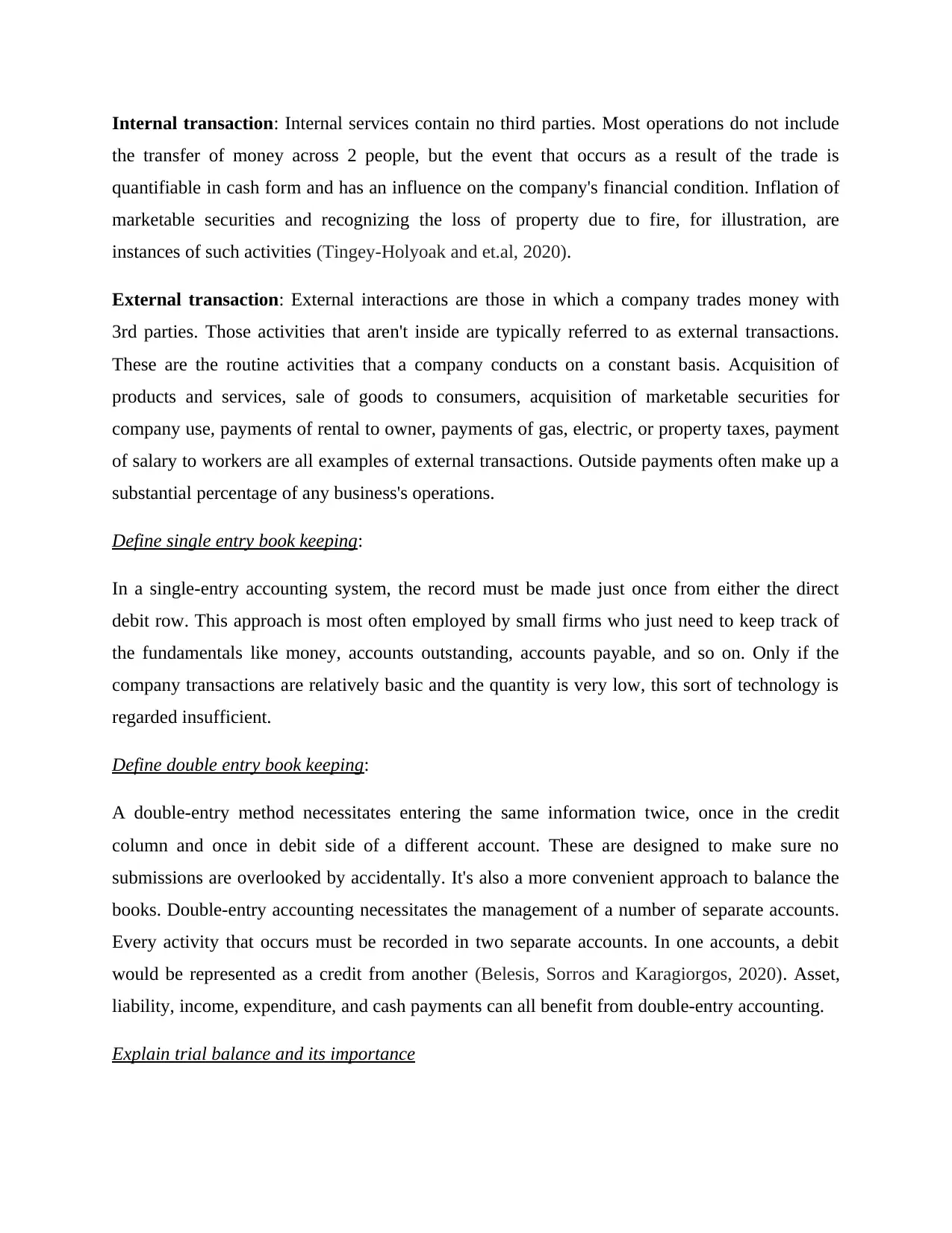
Internal transaction: Internal services contain no third parties. Most operations do not include
the transfer of money across 2 people, but the event that occurs as a result of the trade is
quantifiable in cash form and has an influence on the company's financial condition. Inflation of
marketable securities and recognizing the loss of property due to fire, for illustration, are
instances of such activities (Tingey-Holyoak and et.al, 2020).
External transaction: External interactions are those in which a company trades money with
3rd parties. Those activities that aren't inside are typically referred to as external transactions.
These are the routine activities that a company conducts on a constant basis. Acquisition of
products and services, sale of goods to consumers, acquisition of marketable securities for
company use, payments of rental to owner, payments of gas, electric, or property taxes, payment
of salary to workers are all examples of external transactions. Outside payments often make up a
substantial percentage of any business's operations.
Define single entry book keeping:
In a single-entry accounting system, the record must be made just once from either the direct
debit row. This approach is most often employed by small firms who just need to keep track of
the fundamentals like money, accounts outstanding, accounts payable, and so on. Only if the
company transactions are relatively basic and the quantity is very low, this sort of technology is
regarded insufficient.
Define double entry book keeping:
A double-entry method necessitates entering the same information twice, once in the credit
column and once in debit side of a different account. These are designed to make sure no
submissions are overlooked by accidentally. It's also a more convenient approach to balance the
books. Double-entry accounting necessitates the management of a number of separate accounts.
Every activity that occurs must be recorded in two separate accounts. In one accounts, a debit
would be represented as a credit from another (Belesis, Sorros and Karagiorgos, 2020). Asset,
liability, income, expenditure, and cash payments can all benefit from double-entry accounting.
Explain trial balance and its importance
the transfer of money across 2 people, but the event that occurs as a result of the trade is
quantifiable in cash form and has an influence on the company's financial condition. Inflation of
marketable securities and recognizing the loss of property due to fire, for illustration, are
instances of such activities (Tingey-Holyoak and et.al, 2020).
External transaction: External interactions are those in which a company trades money with
3rd parties. Those activities that aren't inside are typically referred to as external transactions.
These are the routine activities that a company conducts on a constant basis. Acquisition of
products and services, sale of goods to consumers, acquisition of marketable securities for
company use, payments of rental to owner, payments of gas, electric, or property taxes, payment
of salary to workers are all examples of external transactions. Outside payments often make up a
substantial percentage of any business's operations.
Define single entry book keeping:
In a single-entry accounting system, the record must be made just once from either the direct
debit row. This approach is most often employed by small firms who just need to keep track of
the fundamentals like money, accounts outstanding, accounts payable, and so on. Only if the
company transactions are relatively basic and the quantity is very low, this sort of technology is
regarded insufficient.
Define double entry book keeping:
A double-entry method necessitates entering the same information twice, once in the credit
column and once in debit side of a different account. These are designed to make sure no
submissions are overlooked by accidentally. It's also a more convenient approach to balance the
books. Double-entry accounting necessitates the management of a number of separate accounts.
Every activity that occurs must be recorded in two separate accounts. In one accounts, a debit
would be represented as a credit from another (Belesis, Sorros and Karagiorgos, 2020). Asset,
liability, income, expenditure, and cash payments can all benefit from double-entry accounting.
Explain trial balance and its importance
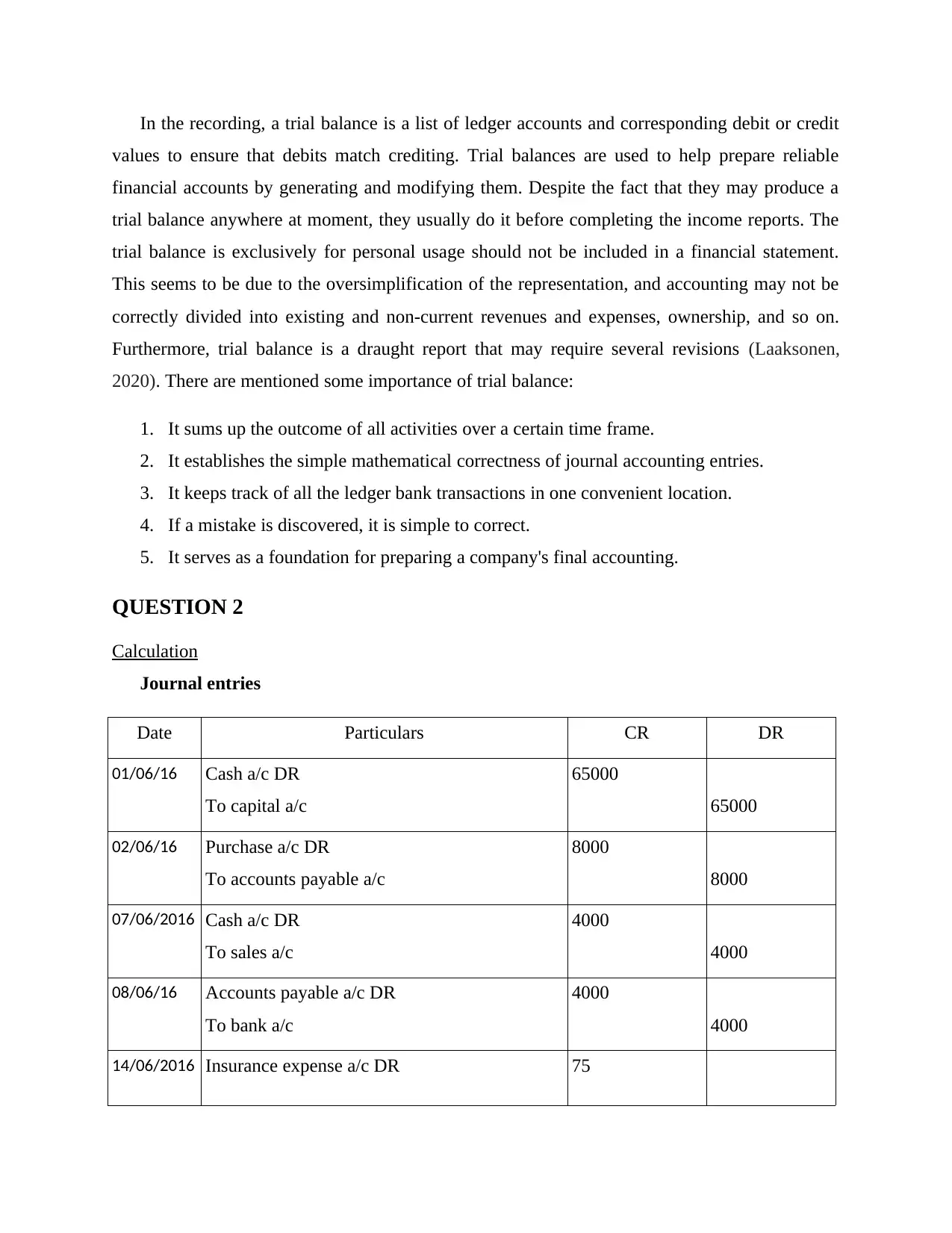
In the recording, a trial balance is a list of ledger accounts and corresponding debit or credit
values to ensure that debits match crediting. Trial balances are used to help prepare reliable
financial accounts by generating and modifying them. Despite the fact that they may produce a
trial balance anywhere at moment, they usually do it before completing the income reports. The
trial balance is exclusively for personal usage should not be included in a financial statement.
This seems to be due to the oversimplification of the representation, and accounting may not be
correctly divided into existing and non-current revenues and expenses, ownership, and so on.
Furthermore, trial balance is a draught report that may require several revisions (Laaksonen,
2020). There are mentioned some importance of trial balance:
1. It sums up the outcome of all activities over a certain time frame.
2. It establishes the simple mathematical correctness of journal accounting entries.
3. It keeps track of all the ledger bank transactions in one convenient location.
4. If a mistake is discovered, it is simple to correct.
5. It serves as a foundation for preparing a company's final accounting.
QUESTION 2
Calculation
Journal entries
Date Particulars CR DR
01/06/16 Cash a/c DR
To capital a/c
65000
65000
02/06/16 Purchase a/c DR
To accounts payable a/c
8000
8000
07/06/2016 Cash a/c DR
To sales a/c
4000
4000
08/06/16 Accounts payable a/c DR
To bank a/c
4000
4000
14/06/2016 Insurance expense a/c DR 75
values to ensure that debits match crediting. Trial balances are used to help prepare reliable
financial accounts by generating and modifying them. Despite the fact that they may produce a
trial balance anywhere at moment, they usually do it before completing the income reports. The
trial balance is exclusively for personal usage should not be included in a financial statement.
This seems to be due to the oversimplification of the representation, and accounting may not be
correctly divided into existing and non-current revenues and expenses, ownership, and so on.
Furthermore, trial balance is a draught report that may require several revisions (Laaksonen,
2020). There are mentioned some importance of trial balance:
1. It sums up the outcome of all activities over a certain time frame.
2. It establishes the simple mathematical correctness of journal accounting entries.
3. It keeps track of all the ledger bank transactions in one convenient location.
4. If a mistake is discovered, it is simple to correct.
5. It serves as a foundation for preparing a company's final accounting.
QUESTION 2
Calculation
Journal entries
Date Particulars CR DR
01/06/16 Cash a/c DR
To capital a/c
65000
65000
02/06/16 Purchase a/c DR
To accounts payable a/c
8000
8000
07/06/2016 Cash a/c DR
To sales a/c
4000
4000
08/06/16 Accounts payable a/c DR
To bank a/c
4000
4000
14/06/2016 Insurance expense a/c DR 75
⊘ This is a preview!⊘
Do you want full access?
Subscribe today to unlock all pages.

Trusted by 1+ million students worldwide

To bank a/c 75
15/06/16 Accounts receivable a/c DR
To sales a/c
12000
12000
16/06/16 Purchase a/c DR
To accounts payable a/c
10000
10000
18/06/16 Computer equipment a/c DR
To cash a/c
3000
3000
20/06/16 Rent a/c DR
To bank a/c
150
150
21/06/16 Cash a/c DR
To sales a/c
10000
10000
25/06/16 Cash in hand
To bank a/c
100
100
30/06/16 Stationary a/c DR
To cash in hand a/c
30
30
Ledger accounts
15/06/16 Accounts receivable a/c DR
To sales a/c
12000
12000
16/06/16 Purchase a/c DR
To accounts payable a/c
10000
10000
18/06/16 Computer equipment a/c DR
To cash a/c
3000
3000
20/06/16 Rent a/c DR
To bank a/c
150
150
21/06/16 Cash a/c DR
To sales a/c
10000
10000
25/06/16 Cash in hand
To bank a/c
100
100
30/06/16 Stationary a/c DR
To cash in hand a/c
30
30
Ledger accounts
Paraphrase This Document
Need a fresh take? Get an instant paraphrase of this document with our AI Paraphraser
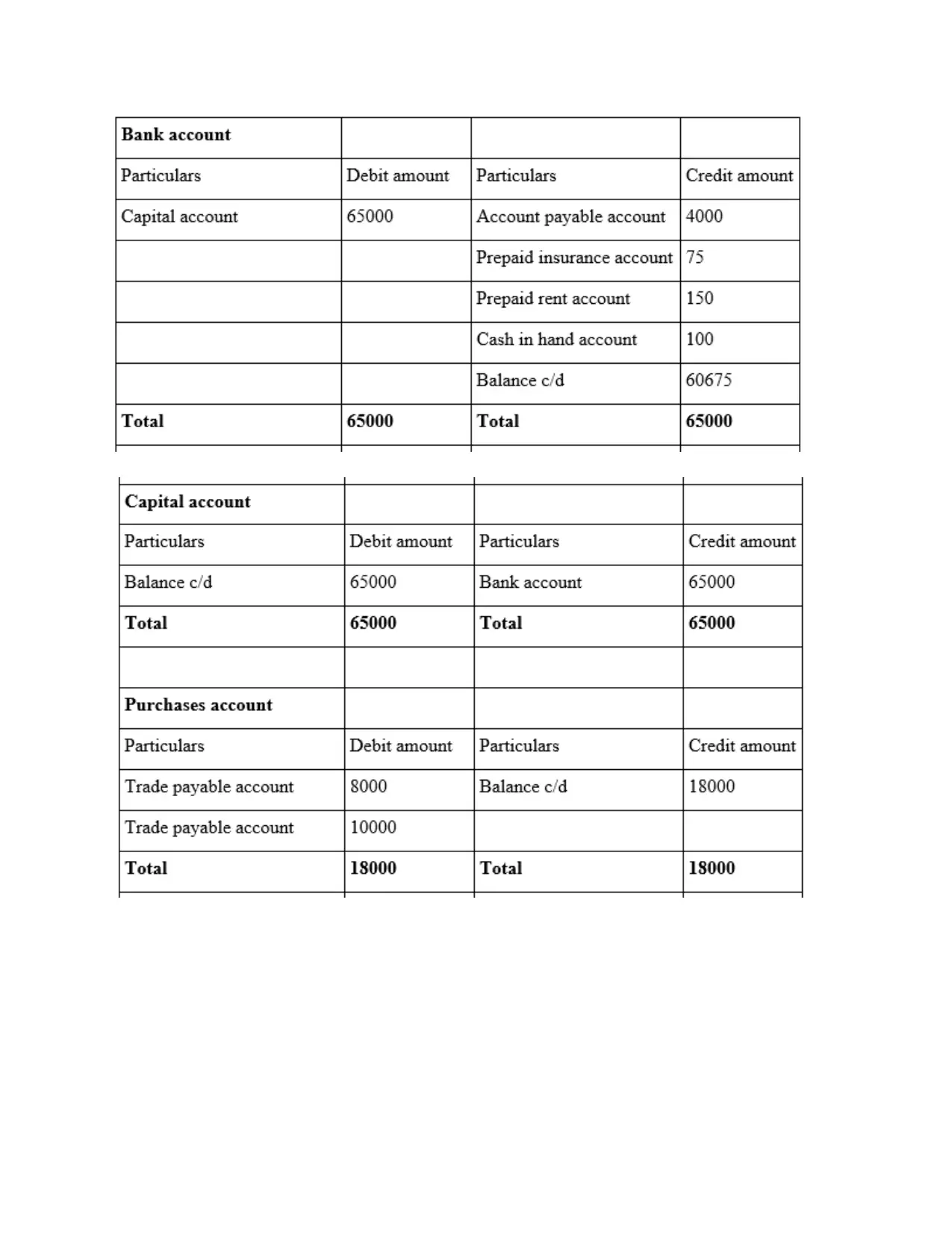
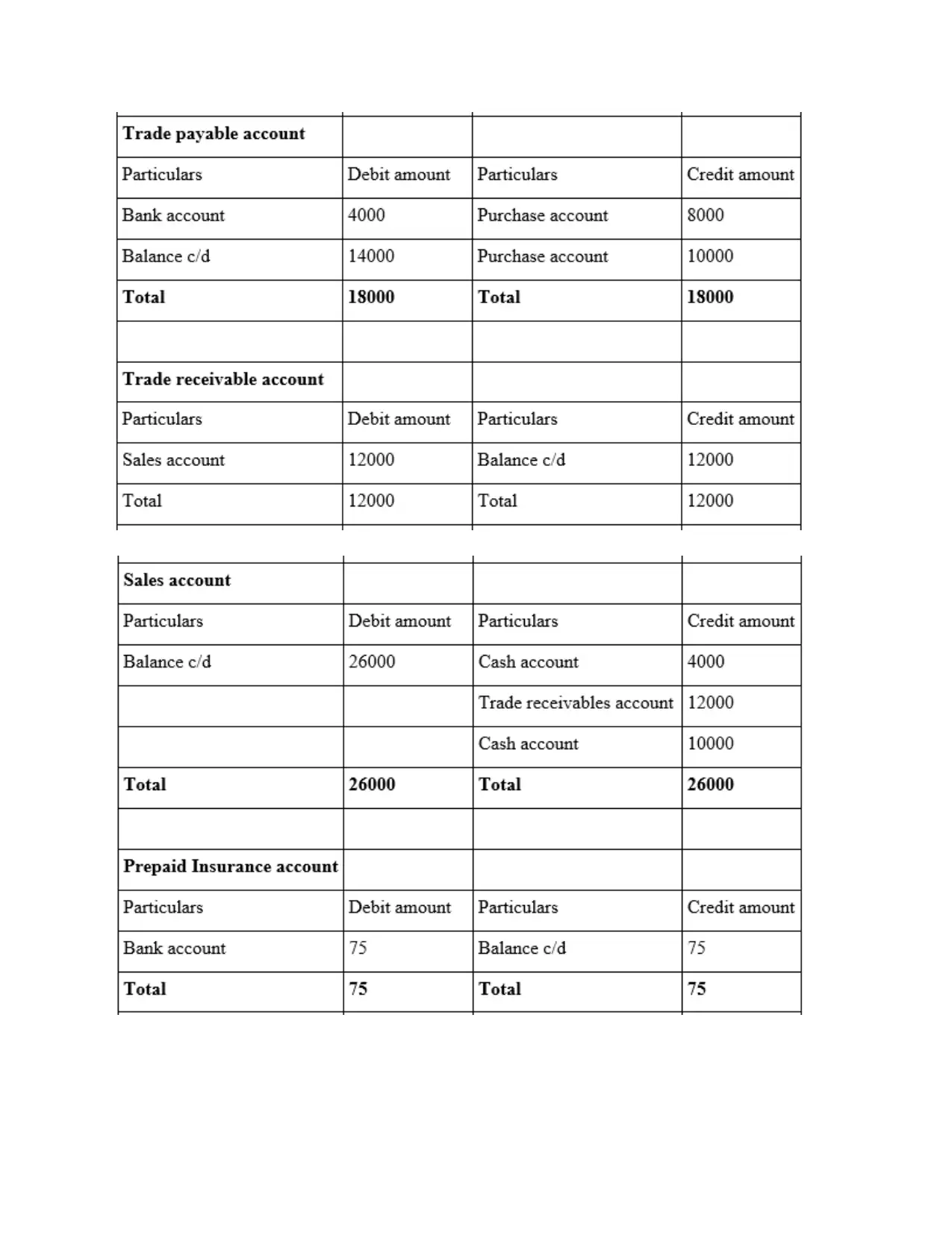
⊘ This is a preview!⊘
Do you want full access?
Subscribe today to unlock all pages.

Trusted by 1+ million students worldwide
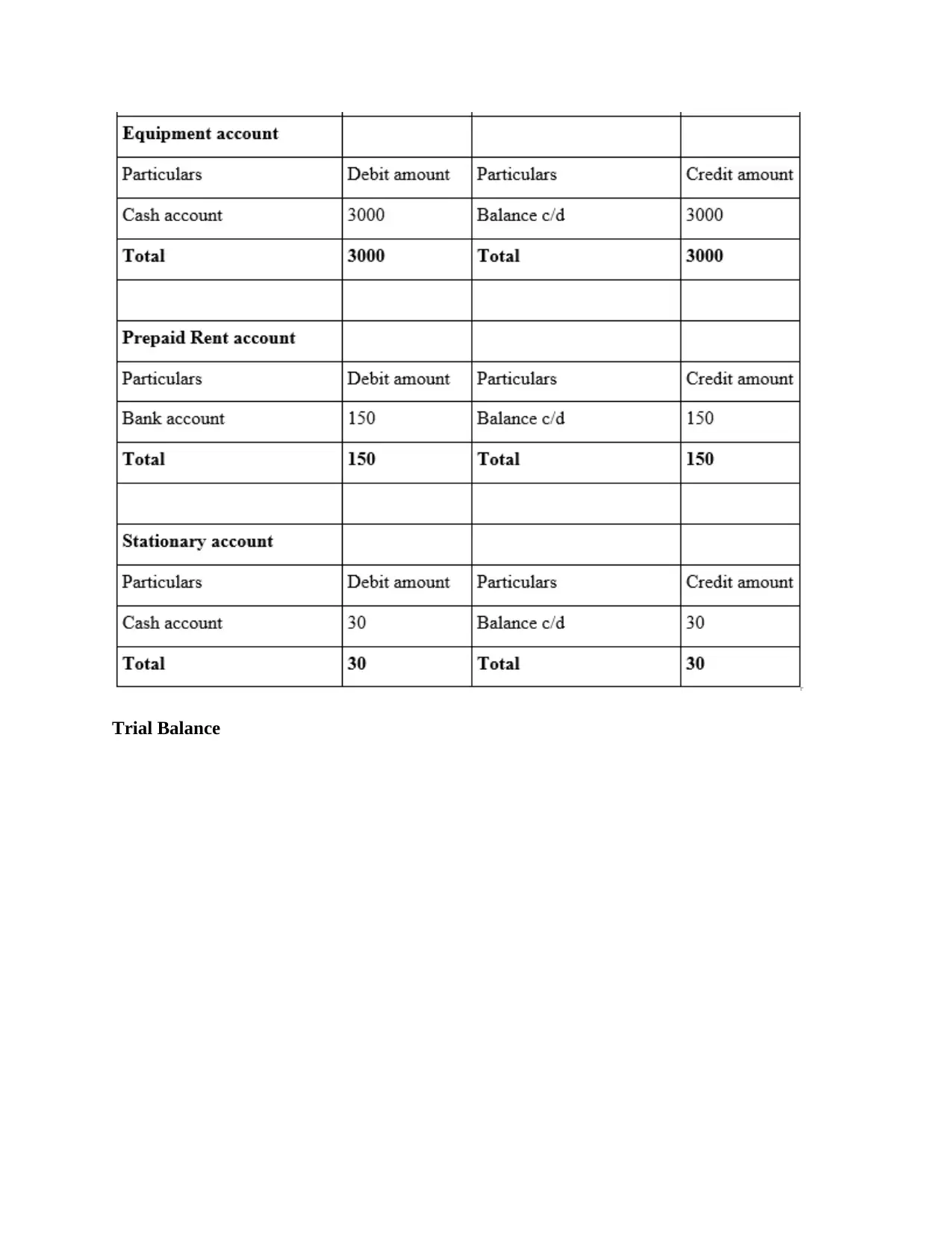
Trial Balance
Paraphrase This Document
Need a fresh take? Get an instant paraphrase of this document with our AI Paraphraser

QUESTION 3
Different between financial statement and financial report
In the profession, the words "financial reporting" and "financial statements" are frequently
used interchangeably. Although the phrases are similar in many ways, financial reporting has a
considerably wider and more thorough meaning. The yearly business information reports that
stockholders examine as component of the financial study includes that both earnings data and
the personal reports (Suwantari, Ariana and Suprapto, 2020).
Financial statements give significant financial knowledge / analysis. Financial statements are
created multiple times during the year to offer financial data to lawyers, financial advisers, other
strategists inside the company so that they may manage and payroll taxes. Every one of the
annual reports are totaled together once every year, usually at the conclusion of the calendar
week, to generate the tax info for a financial report. To finalize the financial report, the author
must obtain company's accounting from transactions and training expenses, as the financial
reports only reveal the corporation's revenue.
Different between financial statement and financial report
In the profession, the words "financial reporting" and "financial statements" are frequently
used interchangeably. Although the phrases are similar in many ways, financial reporting has a
considerably wider and more thorough meaning. The yearly business information reports that
stockholders examine as component of the financial study includes that both earnings data and
the personal reports (Suwantari, Ariana and Suprapto, 2020).
Financial statements give significant financial knowledge / analysis. Financial statements are
created multiple times during the year to offer financial data to lawyers, financial advisers, other
strategists inside the company so that they may manage and payroll taxes. Every one of the
annual reports are totaled together once every year, usually at the conclusion of the calendar
week, to generate the tax info for a financial report. To finalize the financial report, the author
must obtain company's accounting from transactions and training expenses, as the financial
reports only reveal the corporation's revenue.
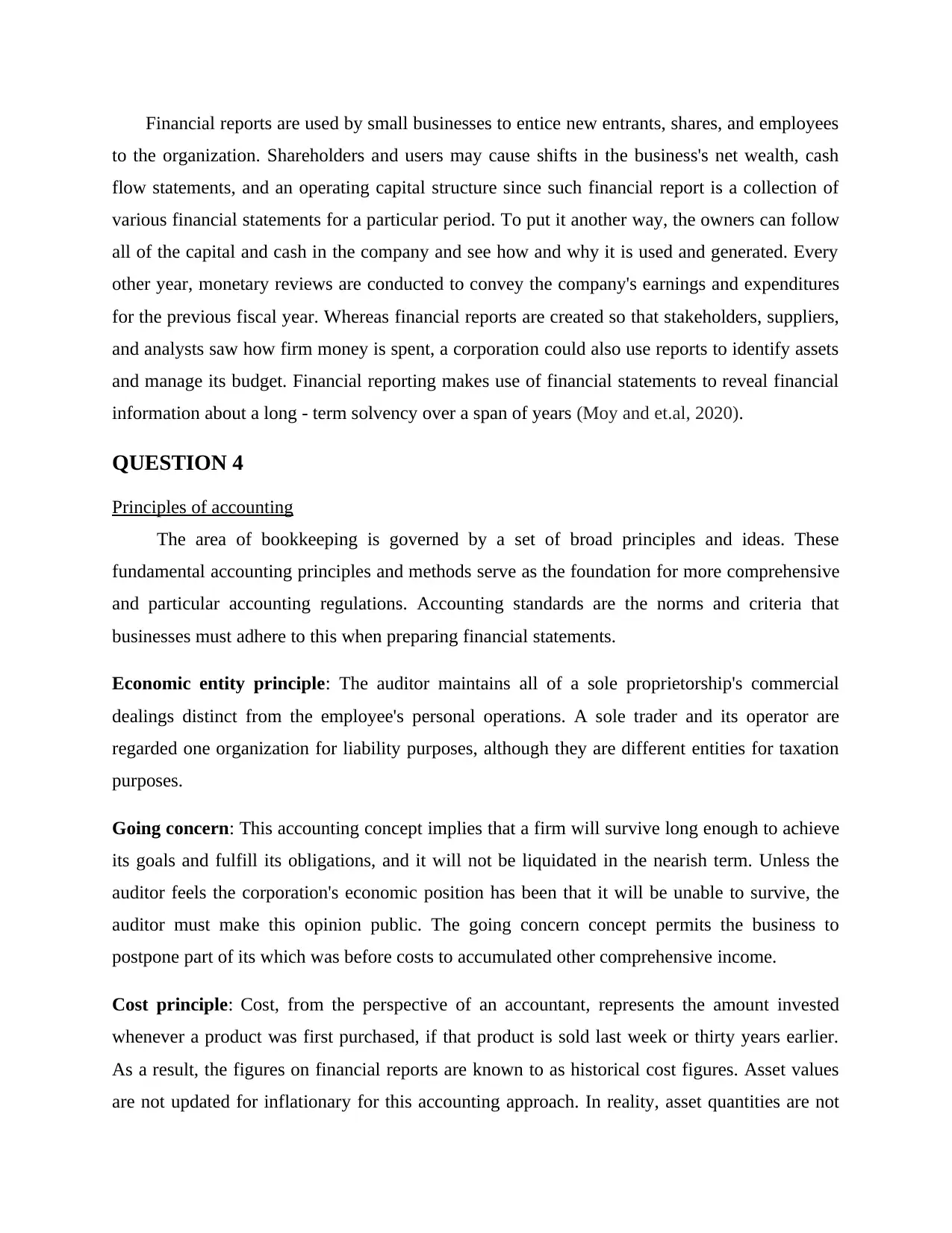
Financial reports are used by small businesses to entice new entrants, shares, and employees
to the organization. Shareholders and users may cause shifts in the business's net wealth, cash
flow statements, and an operating capital structure since such financial report is a collection of
various financial statements for a particular period. To put it another way, the owners can follow
all of the capital and cash in the company and see how and why it is used and generated. Every
other year, monetary reviews are conducted to convey the company's earnings and expenditures
for the previous fiscal year. Whereas financial reports are created so that stakeholders, suppliers,
and analysts saw how firm money is spent, a corporation could also use reports to identify assets
and manage its budget. Financial reporting makes use of financial statements to reveal financial
information about a long - term solvency over a span of years (Moy and et.al, 2020).
QUESTION 4
Principles of accounting
The area of bookkeeping is governed by a set of broad principles and ideas. These
fundamental accounting principles and methods serve as the foundation for more comprehensive
and particular accounting regulations. Accounting standards are the norms and criteria that
businesses must adhere to this when preparing financial statements.
Economic entity principle: The auditor maintains all of a sole proprietorship's commercial
dealings distinct from the employee's personal operations. A sole trader and its operator are
regarded one organization for liability purposes, although they are different entities for taxation
purposes.
Going concern: This accounting concept implies that a firm will survive long enough to achieve
its goals and fulfill its obligations, and it will not be liquidated in the nearish term. Unless the
auditor feels the corporation's economic position has been that it will be unable to survive, the
auditor must make this opinion public. The going concern concept permits the business to
postpone part of its which was before costs to accumulated other comprehensive income.
Cost principle: Cost, from the perspective of an accountant, represents the amount invested
whenever a product was first purchased, if that product is sold last week or thirty years earlier.
As a result, the figures on financial reports are known to as historical cost figures. Asset values
are not updated for inflationary for this accounting approach. In reality, asset quantities are not
to the organization. Shareholders and users may cause shifts in the business's net wealth, cash
flow statements, and an operating capital structure since such financial report is a collection of
various financial statements for a particular period. To put it another way, the owners can follow
all of the capital and cash in the company and see how and why it is used and generated. Every
other year, monetary reviews are conducted to convey the company's earnings and expenditures
for the previous fiscal year. Whereas financial reports are created so that stakeholders, suppliers,
and analysts saw how firm money is spent, a corporation could also use reports to identify assets
and manage its budget. Financial reporting makes use of financial statements to reveal financial
information about a long - term solvency over a span of years (Moy and et.al, 2020).
QUESTION 4
Principles of accounting
The area of bookkeeping is governed by a set of broad principles and ideas. These
fundamental accounting principles and methods serve as the foundation for more comprehensive
and particular accounting regulations. Accounting standards are the norms and criteria that
businesses must adhere to this when preparing financial statements.
Economic entity principle: The auditor maintains all of a sole proprietorship's commercial
dealings distinct from the employee's personal operations. A sole trader and its operator are
regarded one organization for liability purposes, although they are different entities for taxation
purposes.
Going concern: This accounting concept implies that a firm will survive long enough to achieve
its goals and fulfill its obligations, and it will not be liquidated in the nearish term. Unless the
auditor feels the corporation's economic position has been that it will be unable to survive, the
auditor must make this opinion public. The going concern concept permits the business to
postpone part of its which was before costs to accumulated other comprehensive income.
Cost principle: Cost, from the perspective of an accountant, represents the amount invested
whenever a product was first purchased, if that product is sold last week or thirty years earlier.
As a result, the figures on financial reports are known to as historical cost figures. Asset values
are not updated for inflationary for this accounting approach. In reality, asset quantities are not
⊘ This is a preview!⊘
Do you want full access?
Subscribe today to unlock all pages.

Trusted by 1+ million students worldwide
1 out of 27
Related Documents
Your All-in-One AI-Powered Toolkit for Academic Success.
+13062052269
info@desklib.com
Available 24*7 on WhatsApp / Email
![[object Object]](/_next/static/media/star-bottom.7253800d.svg)
Unlock your academic potential
Copyright © 2020–2025 A2Z Services. All Rights Reserved. Developed and managed by ZUCOL.





